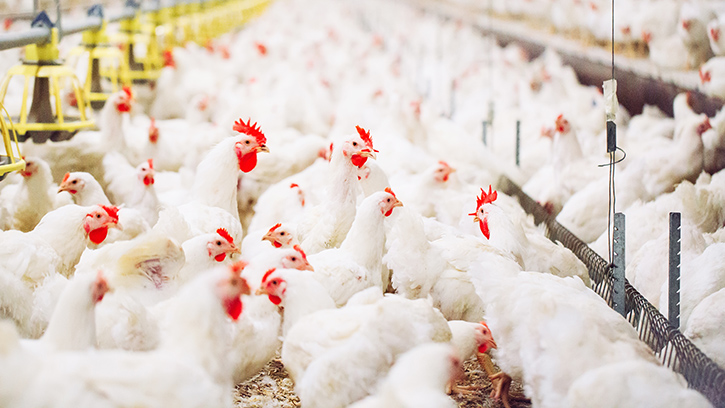In May, PB held the third in its series of webinars in association with the British Poultry Council, sponsored by Elanco Animal Health, chaired by PB editor Chloe Ryan. In it, panellists David Speller, chief executive of OptiFarm, broiler grower and NFU poultry board vice chair Will Raw, and Calum Bell of Elanco who has recently overseen the introduction of AI into Elanco’s systems, discussed the promise and pitfalls of integrating AI into poultry operations. Their insights reveal a nuanced picture of the opportunities.
In the evolving landscape of agriculture, few sectors are as ripe for transformation as poultry farming. As the global demand for protein continues to surge, producers are under increasing pressure to maximise efficiency, improve animal welfare, and maintain transparency with increasingly conscious consumers. Artificial Intelligence (AI) is emerging as a powerful tool to help meet these challenges.
Co-pilot, not replacement
The narrative surrounding AI often sparks images of automation supplanting human roles. In poultry farming, however, the panellists emphasised that AI should be viewed as an enhancement to human expertise, not a replacement.
“AI gives us a chance to scale the best farmers’ knowledge across every shed, every farm, every day,” said David Speller. “That’s what excites us the most.”

AI technologies are being used to track and interpret a wide array of data points including temperature, humidity, air quality, feed intake, and more, creating a digital twin of the poultry shed. This real-time monitoring enables quicker interventions and improved bird welfare.
“It allows me to spend more time with the birds and less time in the office,” added Speller. “When I go into the shed now, I go in with purpose. I know exactly where the issues are.”
From reactive to proactive
Traditionally, poultry farming has been a retrospective exercise. Issues were identified after they occurred, often when the flock had already been affected. With AI, farmers can spot early signals of problems and act before they escalate.
“One of the things we’re trying to do is turn every flock into an opportunity to learn,” explained Will Raw, who for the past 18 months has utilised Pondus technology on his farm. Pondus describes its system, which uses cameras in sheds as ‘AI-powered poultry management providing real-time supply chain intelligence’.

The system makes use of one camera per 10,000 birds in the shed. It’s a static camera that takes a picture every 10 minutes of the birds, and from that it can use algorithms to weigh the birds. It also looks at bird behaviour, including instances of huddling or heat stress. “We’ve also started to look at feeder and drinker activity. So basically it is the eye in the sky,” explained Raw.
AI also empowers less experienced farmers to reach higher performance levels by providing decision support based on aggregate data and historical trends.
“We’re seeing young farmers pick this up incredibly quickly,” added Speller. “They’re using it to challenge old ways of working, and they’re achieving better outcomes.”
Transparency and Perception
While AI brings clear operational benefits, its adoption raises a tricky question: How much do consumers want to know about the inner workings of poultry production?
“There’s a really interesting conflict in my mind,” Chloe Ryan said. “Some consumers don’t want to know about chicken sheds, let alone that robots and computers are involved.”
This highlights a broader industry dilemma: whether to increase transparency or keep the focus on delivering affordable, high-quality food. The key may lie in how technology is framed.
“Across industries, we’re seeing that when AI is portrayed as accelerating the farmer rather than replacing them, it helps build public support,” said Calum Bell. “It’s all about positioning the technology and policies accordingly.”

The panel also discussed the risks posed by AI, including fake images of poor welfare practices.
Speller noted that activists who oppose poultry farming no longer need to break into a farm nowadays. “You just ask some regenerative AI or whatever to make me a clip or make me a photo and hey presto, there you are. It’ll make you a picture.”
The panel discussed how the industry could defend itself. The answer Speller suggested was that the poultry industry needed to have such a strong brand and reputation, consumers would refuse to believe it. “It’s very difficult, if not impossible, to prove that some of this stuff is fake So your brand of the sector and the brand of who you are as a farmer and what you stand for is becoming more important than ever.”
Elanco’s adoption of AI
Bell explained his role in introducing AI to the systems at Elanco and the benefits it had brought to an international animal health company.
“Our mission really is around removing some of the rule-based tasks to give our staff and employees more time to focus on the judgement-based tasks,” Bell said.
Live translations is a prime example. “That’s what some of these new generative our models are very good at. That’s of massive impact when you’re operating across more than 60 countries.”
The second area where Elanco has made use of AI is in report writing. “We produce an awful lot of compliance and internal reports that need to be generated. These are often similar in format, similar in layout and ultimately data-driven. These are great applications to leverage some of the new generative AI capabilities because they can produce a first draught that ultimately a human can pick up and then review and improve.
“Some of our excitement with AI based technologies is really around accelerating the individual, which in turn we hope will just allow them to better serve the animal, serve the customer and serve the industry.”
Supply Chain Planning
AI’s potential extends beyond the farm gate. Experts are increasingly interested in how data-driven tools can optimise the entire poultry supply chain, from forecasting demand to adjusting production schedules.
“Imagine if a long-range weather forecast suggests a great barbecue weekend is coming in eight weeks,” Ryan said. “That could trigger changes all the way back to the hatchery.”
However, predicting consumer behaviour remains a major challenge. Emotions, trends, and unforeseen events all affect demand in ways that are difficult to model.
“You’ve got to be careful not to remove all the variability in the system,” said Speller. “If your predictive model is wrong, and you’ve gone all-in on it, you’re in trouble.”
Still, the aspiration remains. With better forecasting, producers can align supply with demand more precisely, reducing waste and improving margins.
The Economics of AI Adoption
Cost remains a critical barrier to widespread adoption of AI tools in poultry farming. While the benefits are increasingly clear, many farmers hesitate at the initial investment.
“I couldn’t live without AI now,” said Raw. “The return on investment was very quick. I’ve seen reductions in mortality and rejections.
“I wouldn’t want to go back to that kind of retrospective view of thinking where at the end of the crop you think, where did things go wrong? I have data at my fingertips all of the time. I can say ‘right here is the problem, let’s get the correct procedures in to fix this problem’.”
Speller suggested it’s time to rethink the business model. “We’ve got to have grown-up conversations about who pays. I’m using Google Maps today, and I’m not paying them a penny. Someone else is.”
He pointed out that AI models are getting cheaper, and many of the tools rely more on data than expensive hardware. But data security and trust remain essential.
“Ultimately, it comes down to trust,” he said. “I could have anything in my terms and conditions, but unless you trust me to follow them, it doesn’t mean much.”
Getting Started with AI: A Practical Approach
For farms considering AI, the panellists offered three key steps to begin the journey:
Consolidate Your Data: This is often the highest cost and the most crucial step. Without good data, AI tools can’t deliver meaningful insights.
Start Small: Don’t try to overhaul everything at once. Begin with one specific problem, like automating weekly reports.
Invest in AI Literacy: The technology is evolving rapidly. Understanding how to engage with AI: how to prompt it, question it, and apply it will be the real competitive advantage.
“The foundational AI models are becoming commodities,” said Bell. “The secret sauce will be how you aggregate data and train your employees to use the tools effectively.”
He noted that over 4,000 AI start-ups launched in the past year alone. “Tools will come and go. But those who learn how to work with AI will succeed, no matter what platform they’re using.”


